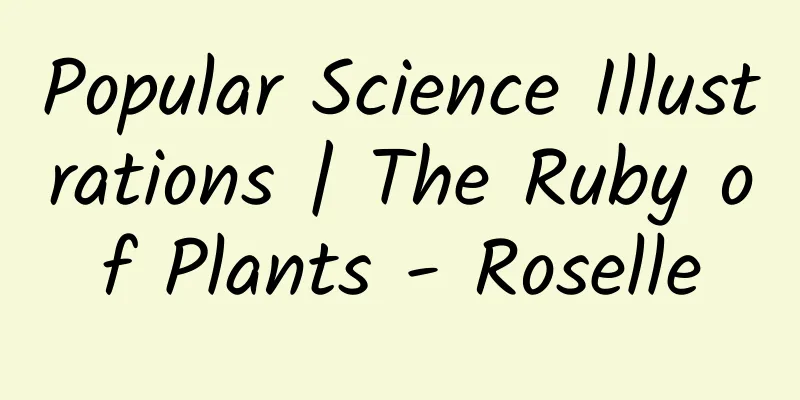Popular Science Illustrations | The Ruby of Plants - Roselle

|
1. Introduction to Roselle Roselle (Hibiscus sabdariffa L.), also known as Roselle and Red Peach K, is an annual herbaceous plant of the genus Hibiscus in the Malvaceae family. Roselle is a tetraploid plant (2n = 4x=72) that originated in Africa. It was introduced to Taiwan in 1910 and is currently cultivated on a large scale in Guangxi, Fujian, Guangdong, Yunnan and other places in my country. It is a tropical and subtropical cash crop with multiple economic uses (Figure 1). Figure 1 Roselle plant 2. Biological characteristics of roselle Roselle is a dicotyledonous plant with a conical taproot system. The stem color is divided into four types: red (Figure 2-a), green (Figure 2-b), purple-red (Figure 2-c), and red-green mosaic (Figure 2-d). The leaves are palmately lobed, and the leaf cycle changes according to certain rules. The leaf cycle is oval-three-lobed-five-lobed-lanceolate (Figure 3). The flower color is divided into yellow (Figure 4-a, b), pink (Figure 4-c), and purple-red (Figure 4-d). There are 3 types; the corolla is separate and spiral, with 5 petals, superimposed, solitary in the axil of the leaves, and the pedicel is short; the anther color is yellow, yellow-brown, and dark brown, bean-shaped, with about 60 anthers per flower; the stigma color is purple and yellow; the calyx of roselle (Figure 5) is fleshy, with 5 to 7 sepals, triangular, acuminate, and inferiorly fused; there are 10 to 14 epicalyx segments, attached to the base of the sepals; the sepals have a distinct midrib, forming a distinct ridge along the edge of the sepals, and there is a distinct gland on the back of the sepals, namely the calyx gland (Figure 6-a), which begins to secrete nectar on the day of flowering; the capsule of roselle is ovoid, with villi on the surface (Figure 6-b), with 5 to 6 chambers per fruit and 4 to 6 seeds per chamber; the seeds are yellow-brown or gray-brown when mature, and the seeds are sub-kidney-shaped (Figure 6-c), with a thousand-grain weight of 30 to 40 grams g; The seed has a large embryo with a micropyle at the top, a diamond-shaped hilum, inverted ovules, a ridge-like band near the micropyle and the hilum, which contains vascular bundles, and a curved funiculus called the seed vein. Figure 2 Morphological characteristics of roselle stem Figure 3 Morphological characteristics of roselle leaves Figure 4 Morphological characteristics of roselle flowers Figure 5 Morphological characteristics of roselle calyx Figure 6 Morphological characteristics of roselle calyx glands, capsules, and seeds 3. The main uses of Roselle 1. Edible use (1) Food coloring As people's quality of life improves, it has become an inevitable trend for natural pigments to replace synthetic pigments. Since the 1960s, a food pigment market dominated by natural pigments has been formed. The total sales of food pigments in the world is about 1.34 billion US dollars, of which synthetic pigments are about 400 million US dollars and natural pigments are about 940 million US dollars. Natural pigments are growing at an annual rate of 10%. Roselle anthocyanin is a natural pigment. my country's "National Food Safety Standard for the Use of Food Additives" (GB 2760-2014) lists roselle red as an edible natural pigment. The Ministry of Health's (86) Fangzi No. 66 document allows roselle pigments to be used in beverages, candies, prepared alcoholic beverages and other foods without restrictions. Therefore, roselle pigments are widely used as colorants in soft drinks, candies, dairy products, solid beverages, fruit wine, fruit vinegar, juice, jelly, pudding, cakes, pastries and other foods. (2) Roselle Food Roselle can be directly processed into roselle enzyme, roselle tea, roselle wine, roselle beverage, jam, candied fruit and other foods. Roselle has been widely used as scented tea. Arabs call it Sudan tea, Europeans and Americans call it Karkade tea, and Chinese call it Roselle tea. (3) Roselle dishes Roselle has a sour taste and is suitable for making sour dishes, such as roselle sweet and sour spareribs, roselle sweet and sour fish, roselle sweet and sour pork feet, roselle stuffed meat, roselle pork belly, roselle vegetable salad, etc. Roselle leaves are a common green vegetable in Africa. The leaves are rich in plant protein, fat, minerals, vitamins, crude fiber and ascorbic acid, which have a good therapeutic effect on common nutritional deficiency diseases such as night blindness, scurvy and rickets in Africans [1]. 2. Medicinal use Roselle is listed in the list of traditional Chinese medicines that can be used as health foods in the 2020 Chinese Pharmacopoeia. Roselle is rich in anthocyanins, polyphenols, polysaccharides, flavonoids and other bioactive ingredients, which can prevent brain cell degeneration, inhibit the occurrence of dementia, and reduce the occurrence of coronary heart disease; it can also effectively treat various blood circulation disorders and inflammatory diseases, and has high health care and medicinal value. (1) Health food Roselle can be used as one of the raw materials for health food, and can be used to make various health products such as anti-aging, blood pressure lowering, and immune regulation. (2) Pharmaceutical preparations Roselle can be used to make medicines such as antibacterial agents, astringents, choleretics, lubricants, digestives, diuretics, emollients, laxatives, cooling agents, dissipants, sedatives, stomachic agents and tonics. For example, in Egypt, Roselle calyx is widely used to treat heart and nerve diseases; in India, Roselle calyx can be used as a diuretic and anti-scurvy drug; in Senegal, Roselle calyx is recommended as a bactericide, anthelmintic and hypotensive agent[2]; in China, the "Roselle Granule" produced by Xiamen Chinese Medicine Factory has the effects of cooling and relieving heat, stimulating appetite and promoting fluid production, and diuresis and detoxification[3]. The development of the medicinal value of Roselle is shown in Table 1. Table 1 Medicinal value and application of Roselle 4. Roselle Products Roselle fleshy calyx has important commercial value. Roselle sepals have rich nutritional value, medicinal value and health care functions. Roselle calyx is rich in soluble roselle red pigment, tastes sour and has bright colors, which has unique advantages as a food colorant. The Institute of Economic Crops of Guangxi Academy of Agricultural Sciences has developed roselle tea (Figure 7), desserts (Figure 8), pastries (Figure 9), home-cooked dishes (Figure 10) and roselle processed products using roselle natural pigments and sour taste. These products have a good taste, have the color, aroma and taste of roselle raw materials, and retain the effective ingredients and color of roselle to the maximum extent. Figure 7 Roselle tea Figure 8 Roselle dessert Figure 9 Roselle pastry Figure 10 Roselle dishes 5. Economic Value and Market Prospects of Roselle 1. Economic Value (1) Economic benefits Roselle is a treasure from head to toe. Its calyx can be used to make tea, beverages, preserved fruits and candied fruits. Its calyx is rich in anthocyanins and hibiscus acid, which have great medicinal and health benefits[4]. Its seeds can be used to extract oil. Its stems can be used as feed and as a raw material for textiles and papermaking. The yield of fresh fruit per mu of Roselle is about 1,200 kg, fresh calyx is about 600 kg, and dried calyx is 72 kg, with a yield benefit of about RMB 10,000 per mu. (2) Ecological benefits Roselle has a strong ecological adaptability, is tolerant to barrenness and drought, and is easy to grow. It can make full use of idle land such as hillsides and in front of and behind houses for cultivation, and can be used as a pioneer crop for barren hills and wastelands. Roselle has a high biological yield, with fresh leaves weighing up to 15 tons per hectare and stems weighing up to 54 tons per hectare. After harvesting, the leaves and branches are returned to the fields, which not only improves soil fertility but also effectively improves soil compaction[5]. The stems can be used as fuel, effectively solving the fuel problem of farmers, and are of great significance to maintaining local ecological balance and preventing soil erosion[6]. (3) Social benefits The roselle industry has played an important role in earning foreign exchange through exports, promoting employment, and solving the “three rural issues” [7]. Lin Dongsheng [5] reported on the intercropping of dwarf crops, roselle, in rubber forests, which helped increase and create income for farm workers. Li Huizhong [6] reported on the high-yield intercropping cultivation model of roselle and corn. The two crops did not affect each other and both achieved high yields, which improved land utilization, promoted farmers’ income growth and local economic development. 2. Market prospects Roselle is a high-value economic crop. Food, medicine, health products and other products developed with calyx and calyx extracts such as anthocyanins as raw materials are sold well at home and abroad, promoting the rapid development of the health industry and rural revitalization industry, and have broad market prospects. In recent years, the United States, Germany, Japan and Southeast Asian countries import more than 3,000 to 4,000 tons of dried sepals of Roselle from the Chinese market for edible processing each year. In China's consumer goods market, the annual sales volume of Roselle has also reached about 1,000 tons. So far, according to incomplete statistics, the global demand for dried sepals for edible processing has also increased year by year, and the annual demand will reach 50,000 to 80,000 tons, creating more than 100 million yuan in foreign exchange income for my country. The Roselle industry is one of the industries with the most development potential at home and abroad in the next few years. References [1] Babalola SO,Babalola AO, Aworh O C. Compositional attributes of the calyces of roselle (Hibiscus sabdariffa L.). Journal of Food Technology in Africa, 2001, 6(4):133-134. [2] Shahidi F, Ho C T. Phenolic compounds in foods and natural health products. Oxford University Press, 2005.114-142. [3] Zeng Tinghua, Xu Xiong, Zhuo Rensong. Chemical components and their utilization of Roselle (a review). Subtropical Plant Newsletter, 1980, (1): 8-18. [4] Lü Dewen. Effects of phosphorus stress on physiological and biochemical functions of roselle seedlings. Anhui Agricultural Science Bulletin, 2012, 18(21): 83-86. [5] Lin Dongsheng. A preliminary study on intercropping roselle in rubber plantations. Fujian Tropical Crops Science and Technology, 1990, (2): 33-34. [6] Li Huizhong. High-yield cultivation technology of roselle intercropped with corn. Yunnan Agriculture, 2011, (7): 13. [7] Chen Muzeng, Liu Dongfeng, Zhuang Biao, Lin Fuzhen. Research on the development of roselle seed oil. China Oils and Fats, 2001, (5): 10-11. About the Team The hemp crop research team of the Institute of Economic Crops of Guangxi Academy of Agricultural Sciences consists of four scientific and technological personnel: Researcher Zhao Yanhong, Associate Researcher Liao Xiaofang, Assistant Researcher Hou Wenhuan, and Assistant Researcher Tang Xingfu. They are mainly engaged in the collection and evaluation of hemp and roselle (a close relative of kenaf) germplasm resources, breeding, and high-yield cultivation technology research. He won 1 second prize in the Guangxi Technological Invention Award (second completing unit) and other 3 scientific and technological awards; presided over more than 20 projects, including 2 National Natural Science Foundation projects and more than 18 provincial, ministerial and departmental projects; presided over 2 platform construction projects, "Nanning Hemp Comprehensive Experimental Station of the National Hemp Industry Technology System" and "Guangxi Bama Specialty Crop Experimental Station"; bred 15 varieties; registered 9 achievements; formulated 3 Guangxi local standards; authorized 14 invention patents; published more than 30 papers, including 7 included in SCI, including 2 papers published in first-tier journals such as Scientific Reports and Industrial Crops and Products; edited two monographs, "Flower Roselle - Take You to Experience the Taste of Roselle" and "Roselle Cultivation, Breeding and Comprehensive Utilization". Produced by: Science Popularization China Author: Zhao Yanhong, Hou Wenhuan, Liao Xiaofang, Tang Xingfu (Institute of Economic Crops, Guangxi Academy of Agricultural Sciences) Coordinator: Cheng Weihong, Xu Qin Producer: China Society of Crop Science, Guangming Online Science Department |
<<: The secret of the biological clock that controls life span is actually hidden in the cells
>>: With a corset, I will have a “slim waist”?
Recommend
Note 8 pre-sale price is hard to exceed 10,000 yuan. It seems Samsung has really hurt the hearts of Chinese consumers.
As the annual flagship new product, Samsung has h...
Does Pu'er tea cause cancer? Drinking tea can cause kidney stones? Do you believe these 5 rumors about tea?
As the ancestor of the beverage industry, tea is ...
Operational promotion: 4 steps to detonate your growth!
What I want to share with you today is that user ...
What you think is normal may actually be 9 manifestations of long-term anxiety! See how many of these you have?
Anxiety is an emotion that everyone experiences, ...
List of 7 essential promotion skills for operators!
Promotional methods + operational knowledge = imp...
The all-new Touareg will debut next year, lighter, bigger and more luxurious
Recently, the third-generation Touareg, which has...
I will never forget this day!
July 7, 2022 It is the 85th anniversary of the Ju...
Marketing promotion: The end of the era of mass screen swiping!
The content that used to attract a lot of attenti...
Analysis of JD.com’s 618 event promotion and operation methods!
Are there too many tricks in this year's 618 ...
China Automobile Dealers Association: The automobile dealer inventory coefficient was 1.76 in October 2022
On November 10, 2022, the China Automobile Dealer...
How to efficiently achieve active user growth?
“ Retention analysis is an important method and a...
From zero to the third largest e-commerce company, how did Pinduoduo increase its user base?
It took Pinduoduo two years and three months to b...
Surgery without anesthesia, life without anxiety, rare gene mutations inspire new medicine
The easiest pain to bear is someone else's. —...
Kuaishou live streaming sales cases for maternal and infant products
Live streaming e-commerce has become a new growth...
Android performance optimization: rendering
Google recently released an online course on Andr...








![[Smart Farmers] One picture to understand: What does a smart LED plant factory that does not require soil look like?](/upload/images/67f23cc0b8ac0.webp)
